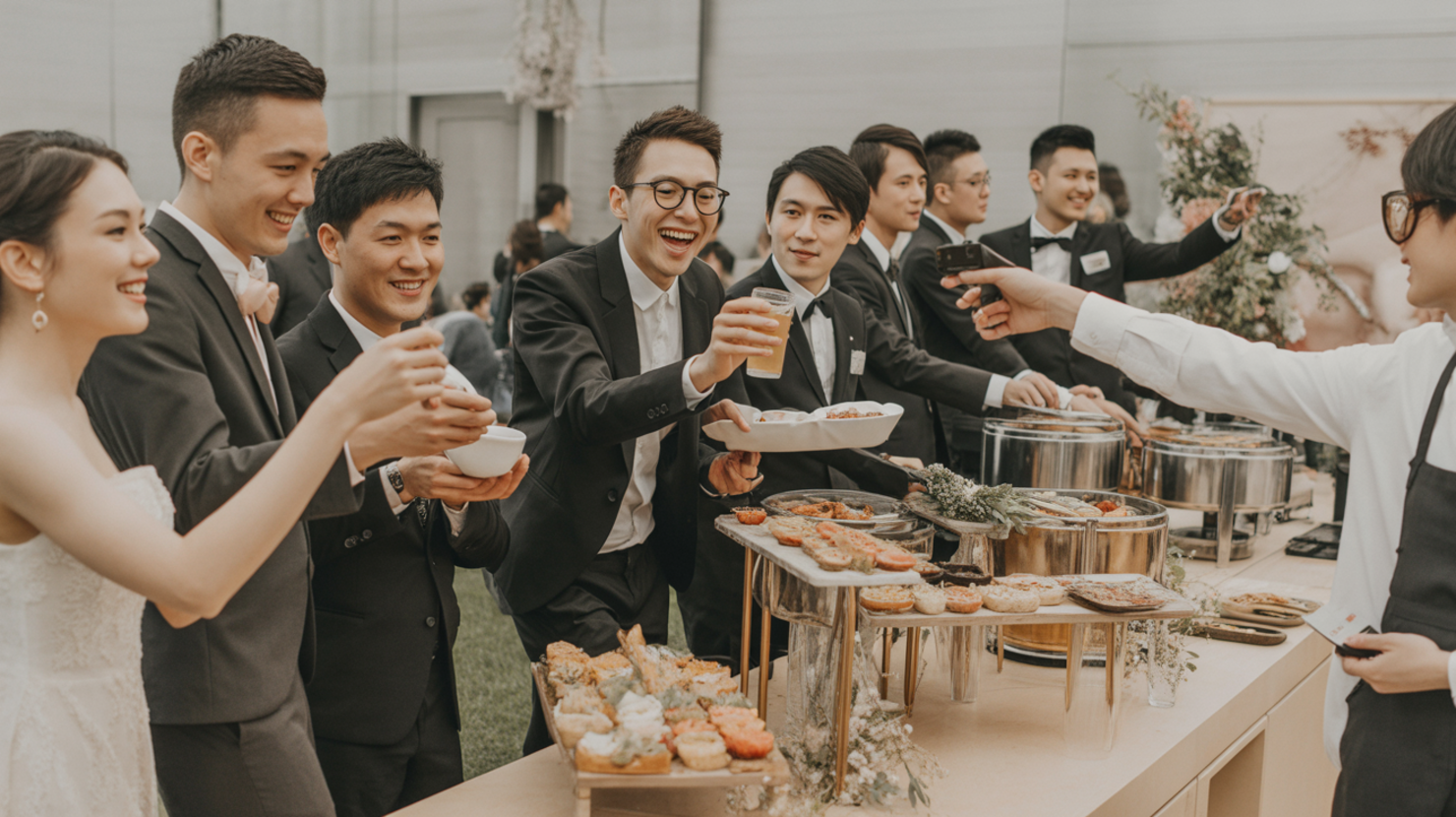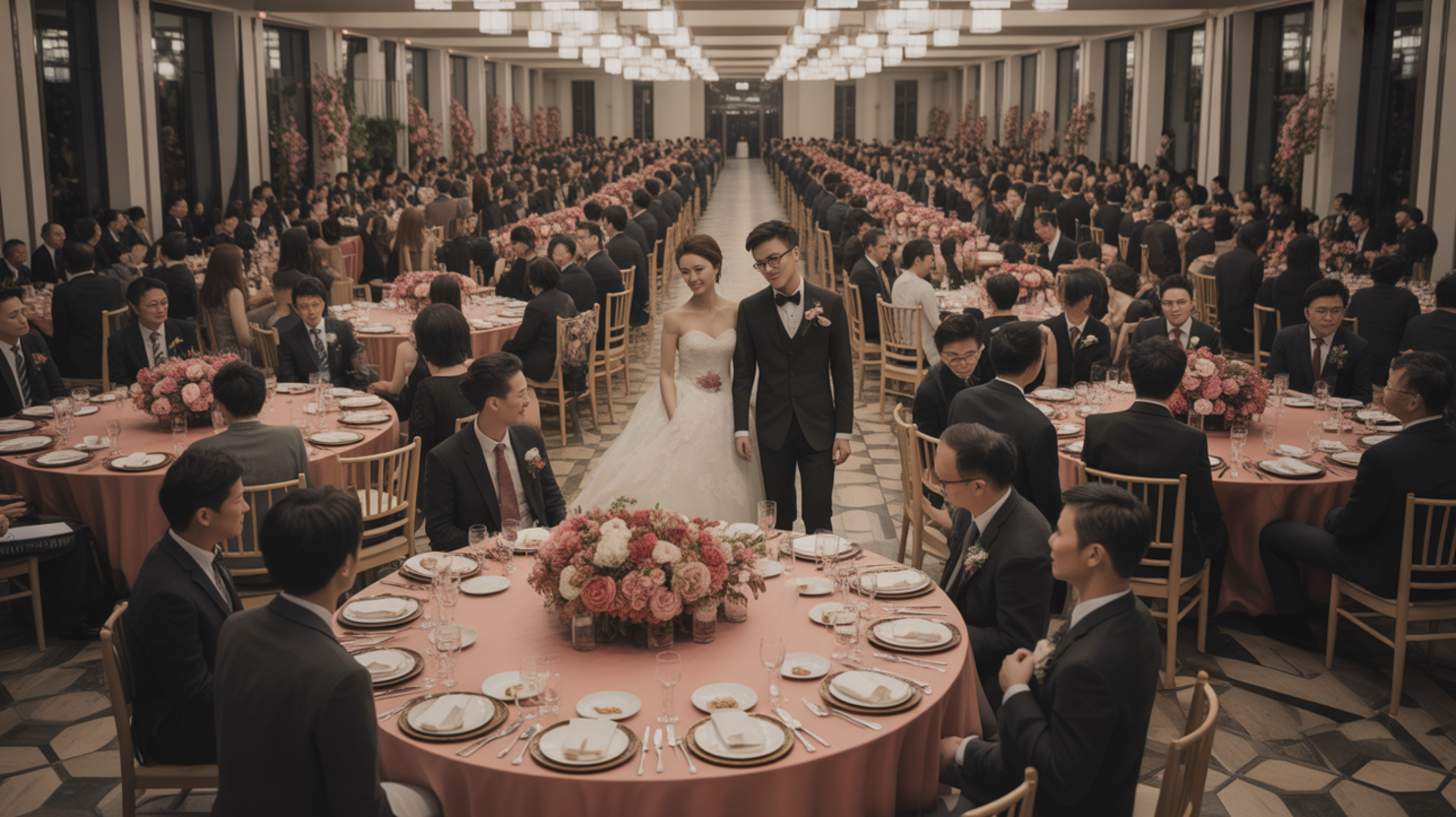From Banquet Halls to Experiential Dining
Chinese wedding banquets have long been synonymous with elaborate multi-course meals, a time-honored tradition symbolizing prosperity and abundance for the newlyweds and their guests. While the core value of sharing a meal remains central, contemporary Chinese wedding venues are witnessing a significant transformation, moving beyond the often rigid 10-course banquet structures towards more dynamic and engaging culinary experiences. This evolution reflects changing guest expectations and a desire for personalized touches in modern celebrations.
The shift is away from seated, pre-determined courses served sequentially, towards a more fluid, interactive environment. Couples are seeking ways to make the dining experience a highlight of the evening, something that guests actively participate in rather than passively consume. This is where the concept of experiential dining comes into play, fundamentally altering how food is presented and enjoyed at these significant events.
A key element of this transformation is the rise of interactive food stations. These aren’t just buffet lines; they are carefully curated setups where guests can watch chefs prepare dishes fresh, often à la minute. These live cooking stations become a form of culinary entertainment, captivating guests with sights, sounds, and aromas. Imagine a station where delicate dim sum is steamed before your eyes, or another where skilled hands pull noodles to perfection. This adds a theatrical element, turning mealtime into a performance.
Crucially, these stations masterfully blend cherished tradition with modern demands for guest customization. While the flavors and dishes may pay homage to classic Chinese cuisine and regional specialties, the format allows guests to choose their preferred ingredients, sauces, and portions. This addresses individual tastes and dietary needs while still honoring the communal spirit of sharing food. It’s a modern reinterpretation of the banquet, allowing for both a nod to heritage and a highly personalized experience for every attendee, making the event feel both grand and intimately tailored. This innovation ensures that the culinary journey at a modern Chinese wedding is as memorable and unique as the couple’s own story.
Cultural Significance of Shared Food Rituals Reimagined
At the heart of any significant Chinese celebration, especially a wedding, lies the shared meal. Food in Chinese culture is far more than simple sustenance; it’s a powerful symbol of unity, prosperity, and auspiciousness. The traditional wedding banquet, while steeped in history, embodies this deeply rooted tradition of communal dining, bringing families and friends together to celebrate the joyous union.
Contemporary Chinese wedding venues are finding innovative ways to honor these values while embracing modern preferences. Interactive food stations represent a thoughtful reinterpretation of communal dining. Instead of passively receiving dishes, guests actively participate in the culinary experience. This hands-on approach transforms the dining area into a vibrant hub, encouraging interaction and shared discovery. It’s about fostering connection through preparing and sharing food, adding a dynamic layer to the traditional feast.
These stations also serve as an interactive storytelling medium. Couples can design stations reflecting their heritage, favorite foods, or even how they met. Imagine a station featuring dishes from the bride’s hometown alongside the groom’s, allowing guests to sample and discuss regional differences. This personalizes the culinary narrative, making the wedding feast uniquely theirs and more engaging for guests who interact directly with the flavors.
Furthermore, the inherent interactivity is excellent for breaking generational divides. Older relatives might explain traditional elements of a dish being prepared, while younger guests are drawn to the novelty and visual appeal. The shared activity of customizing a bowl of noodles or assembling a dim sum platter provides easy conversation starters and common ground, bridging gaps and ensuring guests of all ages feel included and entertained. It transforms dining into a truly shared experience, reflecting the essence of the wedding celebration.
By integrating interactive food stations, contemporary Chinese weddings are not just following a trend; they are evolving a fundamental cultural practice. They keep the spirit of the shared feast alive, making it more engaging, personal, and memorable, ensuring traditional values remain central to the big day. To learn more about food’s importance in Chinese culture, explore resources like the Wikipedia page on Chinese cuisine.
Designing Multi-Sensory Station Experiences
Modern Chinese wedding receptions are evolving, moving beyond traditional seated banquets to embrace dynamic, interactive food stations. This shift isn’t merely about changing the serving method; it’s about deliberately crafting a multi-sensory experience that captivates guests through sight, sound, smell, touch, and, of course, taste. The aesthetic and functional design of these stations is paramount to their success.
A foundational element is the strategic layout of the station area. Placement is crucial for managing guest flow smoothly throughout the event space. Thoughtful planning prevents congestion and ensures that guests can easily access and enjoy each offering. Beyond practicality, the layout contributes significantly to the visual narrative of the reception. Stations should be designed with varying heights, appealing backdrops, and targeted lighting to create compelling focal points that are as beautiful as they are delicious. This attention to visual detail is part of the immersive experience.
Enhancing the ‘live’ aspect involves skillfully incorporating chef performances into the station design. Watching a talented chef in action – be it performing the dramatic pull of La Mian noodles, the precise carving of roast meats, or the artistic assembly of intricate desserts – adds energy and entertainment. These performances engage multiple senses; the sizzle of the pan, the aroma of cooking spices, and the visual spectacle of culinary mastery. Guests aren’t just receiving food; they are witnessing its creation, making the interaction with the station more memorable and personal.
Furthermore, thematic design allows couples to infuse their unique story and personalities into the culinary landscape. Stations can be thoughtfully curated to reflect significant moments in the couple’s journey – perhaps featuring dishes from a cherished travel destination, representing their respective family origins, or highlighting shared culinary passions. This personalization transforms the food stations into edible chapters of the couple’s narrative, creating delightful surprises and conversation starters for guests. By focusing intensely on these layers of design – flow, visual appeal, live performance, and personal theme – contemporary Chinese wedding venues are turning simple food service into truly unforgettable, multi-sensory celebrations.
Regional Cuisine Reimagined for Interaction
Moving beyond static buffet lines, contemporary Chinese wedding venues are embracing the rich tapestry of regional cuisines, transforming traditional dishes into engaging, interactive experiences. This approach allows guests to not only savor authentic flavors but also participate in the culinary process, adding a memorable layer to the celebration. It’s about presenting familiar tastes in unexpected and dynamic ways.
One popular innovation is the deconstructed dim sum station. Instead of pre-plated baskets, guests can approach a setup featuring various dumpling wrappers, a selection of traditional and contemporary fillings (like shrimp, pork, mushrooms, or even modern twists like truffle), and an array of dipping sauces. Guests can choose their components, and a chef or attendant can then steam the dumplings fresh on demand. This offers guests a sense of personalization and discovery, turning the act of eating dim sum into a playful, build-your-own adventure.
Another captivating addition is the interactive noodle-pulling demonstration. Noodle pulling is a traditional art form requiring skill and precision. Bringing this live performance to a wedding creates a visual spectacle that delights guests. Watching dough transform into dozens of silky strands right before their eyes is fascinating. Paired with a choice of broths and toppings, guests receive incredibly fresh noodles, tailored to their preference. This station celebrates culinary craftsmanship and adds a theatrical element to the dining experience.
For a modern twist on dessert, some venues are incorporating stations featuring techniques like liquid nitrogen. While not traditionally Chinese, using such methods to prepare desserts with regional flavors (like mango pudding, red bean, or matcha) creates a stunning, multi-sensory presentation. Guests can watch as ingredients are instantly frozen, producing ethereal mists and unique textures. It’s a fusion of cutting-edge culinary science and classic flavors, providing a show-stopping finale to the meal and offering guests a futuristic taste experience.
By reimagining regional cuisine through interactive stations, wedding venues are creating more than just a meal; they are crafting engaging culinary journeys that celebrate culture, invite participation, and leave a lasting impression on guests.
Tech Integration in Culinary Presentations
Beyond just delicious food, contemporary Chinese wedding venues are incorporating technology to add layers of interactivity and engagement to their food stations. This integration turns a simple serving point into an experience, providing guests with unique ways to interact with the cuisine and the couple’s story.
One fascinating application is using Augmented Reality (AR) to enhance the menu storytelling at stations. Guests can point their smartphone or a venue-provided device at a dish or a menu card and see an interactive overlay. This could reveal details about the dish’s origin, a fun fact about a key ingredient, or even a short video message from the couple explaining why this dish is significant to them. This adds a deeply personal and informative dimension, making the food experience memorable and shareable. Learn more about AR’s potential in interactive experiences.
Another practical tech integration is the use of QR codes to unlock further information or interactive elements. A QR code placed near a DIY station, like a mini Peking duck wrap bar or a build-your-own noodle bowl, could link guests directly to a short, engaging video tutorial demonstrating the best way to assemble their creation. Alternatively, QR codes can provide instant access to a detailed ingredient list for allergy information or link to a digital guestbook for immediate feedback on the station. This empowers guests with information and adds a helpful, modern touch.
Finally, integrating instant social media sharing stations directly into the culinary setup capitalizes on guests’ desire to document and share their experiences. Beyond traditional photo booths, these stations can be designed specifically around the visual appeal of the food presentation. Imagine a beautifully lit dessert station with an integrated photo point and a prompt to use the event’s unique hashtag. Some setups can even display a live feed of posts using the hashtag, creating a communal digital album around the culinary journey of the night. This makes the food stations not just about eating, but about creating and sharing vibrant memories instantly.
By weaving these technological threads into the fabric of the culinary presentation, venues are creating dynamic, personalized, and highly shareable food experiences that go far beyond the traditional buffet, truly capturing the spirit of modern celebrations.
Sustainability Through Engaged Consumption
Beyond the delightful flavors and visual spectacle, interactive food stations at contemporary Chinese weddings are quietly revolutionizing sustainability practices. Moving away from traditional fixed-portion banquets, these dynamic stations empower guests to customize their plates, a simple yet powerful act that significantly contributes to reducing food waste. When attendees serve themselves, they are more likely to take only what they will consume, minimizing untouched or excess food that would otherwise be discarded. This direct engagement fosters a greater awareness of consumption, making sustainability an active part of the guest experience.
Another key aspect of this sustainable shift is the emphasis on seasonal ingredient stations often featuring partnerships with local farms. By sourcing produce, meats, and dairy locally and in season, venues drastically cut down on the environmental impact associated with long-distance transportation and energy-intensive storage. This farm-to-table approach not only ensures fresher, more flavorful dishes but also supports the local economy and reduces the wedding’s overall carbon footprint. It transforms the food station into a showcase of regional bounty and a commitment to environmental responsibility.
Furthermore, the creative design of these stations frequently incorporates edible decor, a charming and effective way to minimize single-use plastics and other non-biodegradable materials. Instead of plastic signage or disposable platters, elements like intricate sugar sculptures, fruit displays, or even garnishes made from herbs grown on-site become part of the station’s aesthetic, ultimately intended for consumption or easy composting. This thoughtful integration of sustainability into design proves that environmental consciousness can be both beautiful and functional. For more insights on reducing food waste, the U.S. Environmental Protection Agency (EPA) offers valuable resources.
By allowing customization, prioritizing local and seasonal sourcing, and opting for edible or compostable decor, interactive food stations demonstrate a commitment to more responsible event planning. They turn dining from a passive activity into an engaged consumption experience, highlighting how modern culinary trends can align with environmental values, ensuring celebrations are not only memorable but also mindful of their impact on the planet. This forward-thinking approach is a testament to how even celebratory events can embrace sustainable practices effectively.
Future Trends in Wedding Gastronomy
Looking ahead, the landscape of wedding dining is poised for fascinating evolution, pushing boundaries beyond traditional banquets and even the current wave of interactive stations. Future trends suggest a move towards even more personalized, dynamic, and experience-driven culinary offerings, reflecting the couple’s unique story and leveraging cutting-edge technology and community connections.
One exciting frontier lies in the integration of artificial intelligence. Imagine AI-powered personalized flavor pairings, where algorithms analyze guest preferences, dietary needs, and even the overall wedding theme to suggest bespoke menu items or station offerings. This could lead to highly customized culinary experiences for each guest, moving beyond simple allergy accommodations to truly tailored taste profiles, ensuring every bite resonates personally.
Another anticipated trend is the rise of multi-course progressive tasting journeys. Instead of guests visiting stations freely, or sitting for a fixed sequence, this concept involves smaller, curated courses served at different locations or specific times throughout the venue. This creates a narrative arc with the food, turning the meal into an immersive part of the wedding’s flow, perhaps with each course corresponding to a different chapter of the couple’s relationship or a different aspect of their heritage. It elevates the culinary experience to a performance art, engaging guests actively.
Furthermore, expect to see increasing collaborations with local culinary startups and artisans. This trend not only supports small businesses and promotes sustainability by using local ingredients but also introduces unique, innovative flavors and concepts that large catering companies might not offer. Think niche food trucks offering late-night snacks, artisanal ice cream creators crafting custom flavors, or local bakers providing unique dessert station elements. Partnering with these dynamic entities brings a fresh, authentic, and often unexpected dimension to the wedding feast.
These future trends — leveraging AI for personalization, designing food as a progressive journey, and fostering collaborations with local innovators — paint a picture of wedding gastronomy that is not just delicious, but deeply meaningful, technologically advanced, and community-connected. The focus is on creating culinary experiences that are as memorable and unique as the couples themselves.



